Key takeaways
- French photography, exemplified by artists like Henri Cartier-Bresson and Robert Doisneau, blends emotion and artistry to capture the human experience.
- Framing is crucial for storytelling in photography, enhancing the subject through creative compositions and natural elements.
- Timing, angles, and weather significantly influence the quality of river photography, providing opportunities for unique perspectives and emotional resonance.
- Personal experiences along the Seine serve as a source of inspiration, transforming simple photographs into profound narratives of beauty and connection.
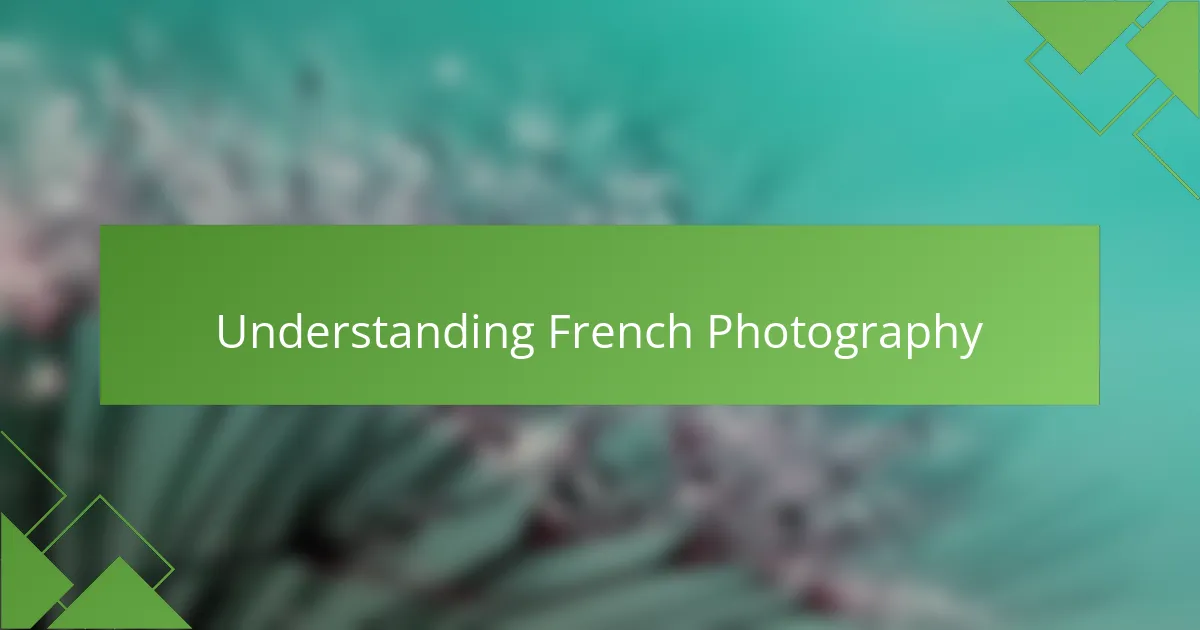
Understanding French Photography
French photography is a rich tapestry woven with emotion and artistry. When I think of iconic French photographers, names like Henri Cartier-Bresson and Robert Doisneau come to mind. Their work not only captures visuals but tells stories that resonate with the human experience.
I remember standing in front of a Doisneau piece at a gallery, feeling an instant connection. It was as if the frozen moment in time spoke to me, enchanting me with nostalgia and whimsy. Can a photograph really evoke such emotions? Absolutely! The ability of French photographers to blend daily life with poetic aesthetics is what makes this genre so captivating.
Another remarkable aspect of French photography is its emphasis on light and composition. I’ve often found myself pondering how photographers balance technical skill with creative intuition. The play of light on historical streets or the reflection in a serene Seine River can transform an ordinary scene into something extraordinary. It’s this pursuit of beauty in the mundane that keeps me inspired in my own work.
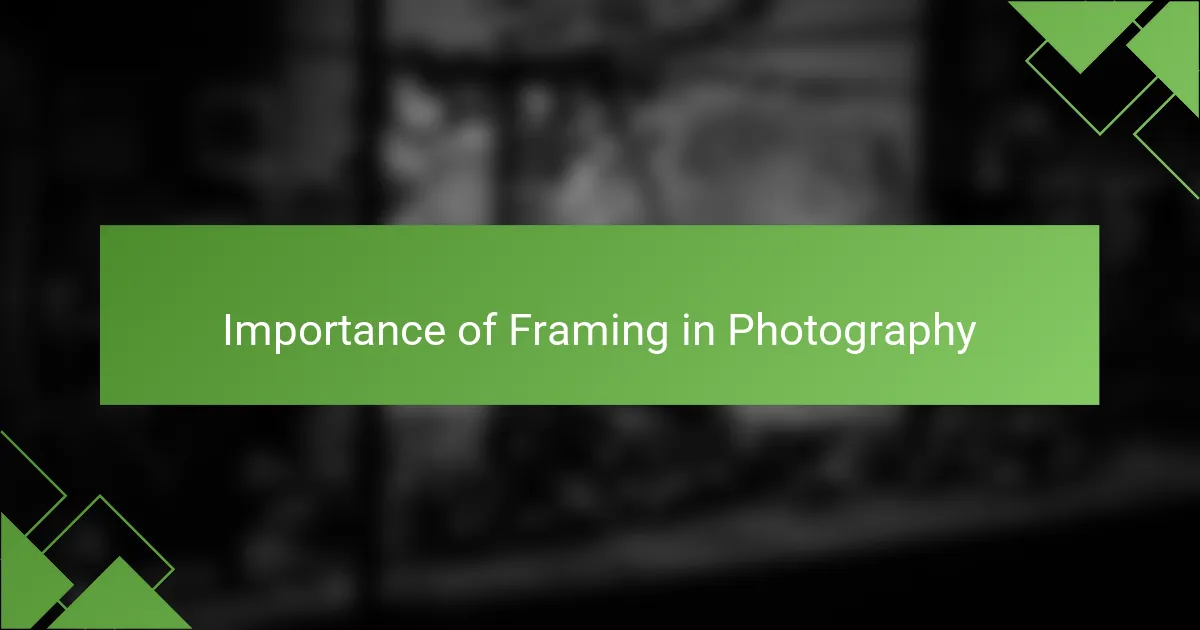
Importance of Framing in Photography
Framing is essential in photography because it directs the viewer’s eye to the subject, creating a compelling composition. For me, when I framed the Seine River, I realized that the elements I chose to include—like the trees lining the banks and the historical bridges—enhanced the story I wanted to tell. Each frame I captured evoked emotions tied to the beauty and history of the location, making each photograph resonate on a deeper level.
In my experience, experimenting with framing can transform an ordinary scene into something extraordinary. By using natural frames, such as archways or overhanging branches, I found that my images felt more intimate and inviting. This technique not only highlights the river but also invites viewers to immerse themselves in the moment as if they were there with me.
| Standard Framing | Creative Framing |
|---|---|
| Focuses on the main subject | Uses elements in the environment to enhance the subject |
| More traditional compositions | Often results in unique perspectives |
| Can lead to powerful, straightforward images | Creates atmosphere and evokes emotion |
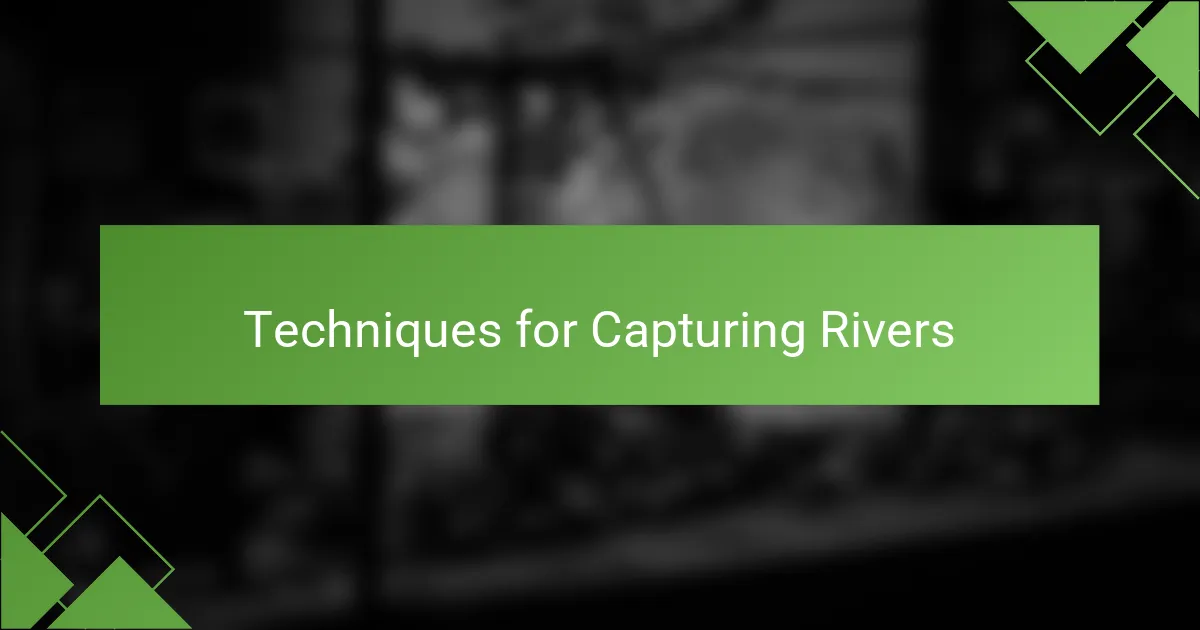
Techniques for Capturing Rivers
Capturing rivers, like the Seine, requires an understanding of both light and movement. I often find that early mornings, when the sun rises softly, offer the most magical moments. The way the light dances on the water creates a shimmering effect that can make a photograph feel almost ethereal. Have you ever considered how the time of day influences the mood of your images? For me, the early light is transformative, and I always try to get to my spot before sunrise to seize those fleeting moments.
Another technique I enjoy employing is long exposure photography. By using a neutral density filter, I can smooth out the water’s surface, creating a serene and dreamlike quality. I remember setting up my tripod along the Seine one evening, watching the boats drift by while the world around me blurred into a soft whisper. It’s fascinating how this technique can evoke feelings of calm, isn’t it? I think it’s a powerful way to convey the river’s tranquility while still acknowledging its life and movement.
Lastly, I love to incorporate reflections into my river photographs. When the water is still, I can capture the stunning ripples of light and color that mirror the surroundings. This technique adds depth and interest to the composition. I once took a shot where the historic buildings along the Seine were reflected perfectly in the water, creating a harmonious blend of reality and art. Can you imagine the stunning image that creates? It’s these little details that turn a simple river scene into a captivating story waiting to be told.
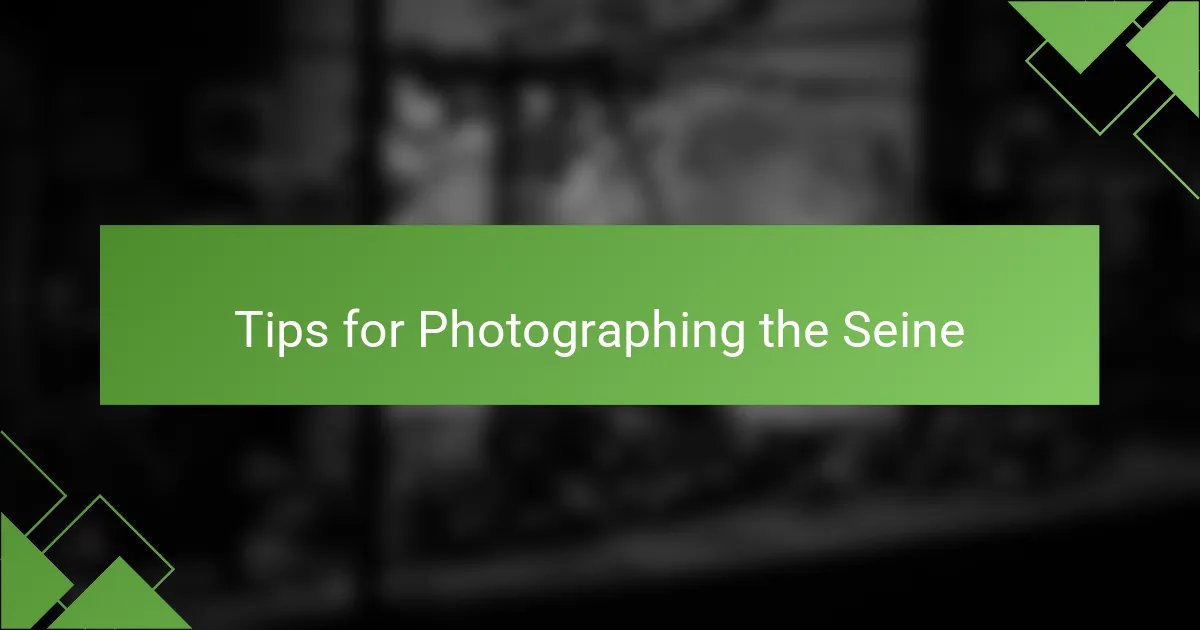
Tips for Photographing the Seine
When photographing the Seine River, timing can make all the difference. I’ve found that early mornings usher in a soft, golden light that bathes the water and surrounding architecture. This magical glow brings out the colors in the reflections beautifully, creating a serene atmosphere that’s perfect for capturing the essence of Paris.
Another tip is to explore different angles and perspectives. I often like to find higher vantage points. For instance, the view from the bridges or nearby heights offers a wonderful way to frame the river against the skyline, showcasing its winding beauty. Don’t hesitate to get creative with your composition by including elements like the iconic Parisian boats or the distant silhouette of Notre-Dame.
Lastly, consider the weather. Overcast days can produce moody, atmospheric shots, while clear blue skies lend a vibrant backdrop to your photographs. Personally, I cherish the subtle drama that comes with a cloudy sky—a little contrast can evoke such emotion in a photograph.
| Tip | Details |
|---|---|
| Timing | Early mornings provide warm, soft light for stunning photos. |
| Angles | Seek higher viewpoints for unique perspectives of the Seine. |
| Weather | Use overcast days for moody shots or clear days for vibrant captures. |
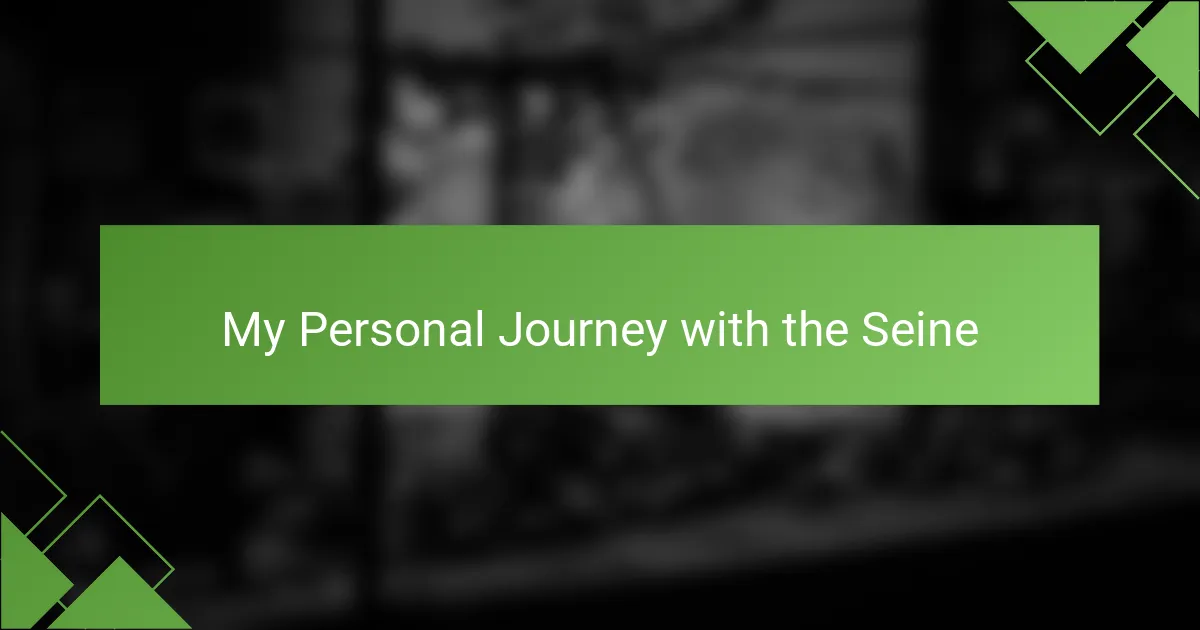
My Personal Journey with the Seine
Standing by the Seine for the first time was a transformative experience for me. I vividly remember feeling the cool breeze and listening to the gentle lapping of the water against the banks. Each click of my camera shutter seemed to resonate with the heartbeat of the city, reinforcing my connection to Paris in a way I never expected. How could such a simple river evoke so much emotion? For me, it was a reflection of the stories that flowed through its currents.
As I began to explore different areas along the Seine, each spot unveiled a unique narrative. One serene afternoon, I wandered down to a quieter section where the sun set behind the trees, casting a warm golden glow across the surface of the water. It felt as though time slowed down, allowing me to immerse myself fully in the moment. I found myself captivated by how light and shadow played together, transforming my photographs into pieces of art that echoed the beauty I witnessed.
Over time, I realized that the Seine River was more than just a backdrop for my photography; it became a muse that pushed me to experiment and grow. I often reflect on how I’ve changed through my journey with this river. The combination of its changing moods—sometimes tranquil, sometimes bustling—has taught me resilience in my craft. Each photograph I framed became a chapter in my personal story, reminding me of the profound relationship between an artist and their subject.
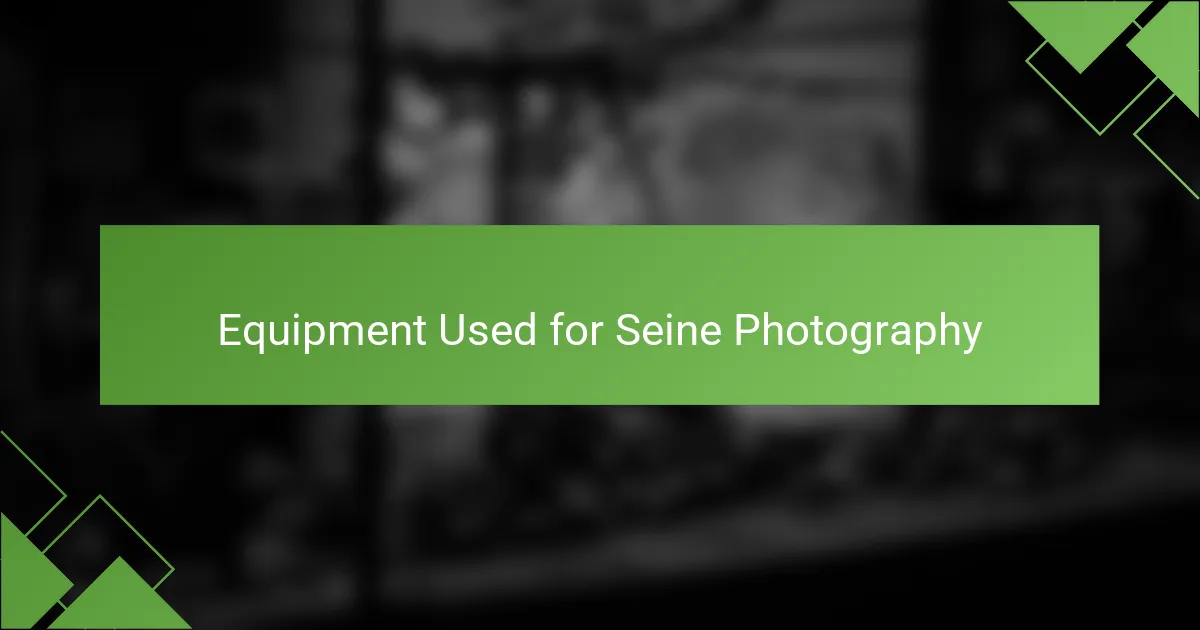
Equipment Used for Seine Photography
The right equipment is crucial when capturing the beauty of the Seine River. I typically opt for a DSLR or a mirrorless camera, both of which offer flexibility and high-quality images. The ability to change lenses allows me to adapt my approach, whether I’m shooting wide to showcase the grandeur of a bridge or zooming in on the delicate details of a riverbank.
In addition to the camera, I never leave without a sturdy tripod. Long exposure shots of the Seine, especially at dawn, require stability to avoid any blurriness. I remember one morning when I arrived just before sunrise. With the tripod set up, the anticipation was palpable. As the first light kissed the water, I felt the excitement of witnessing something special, and that tripod helped me capture it perfectly.
Filters are another essential part of my toolkit. A polarizing filter helps reduce glare from the water’s surface, which is especially useful when the sunlight reflects off the Seine. I still recall the first time I used one—my images transformed, revealing colors and contrasts that just popped. Have you ever tried using a filter? It’s remarkable how this small piece of equipment can elevate your photography game, turning good shots into stunning visuals.
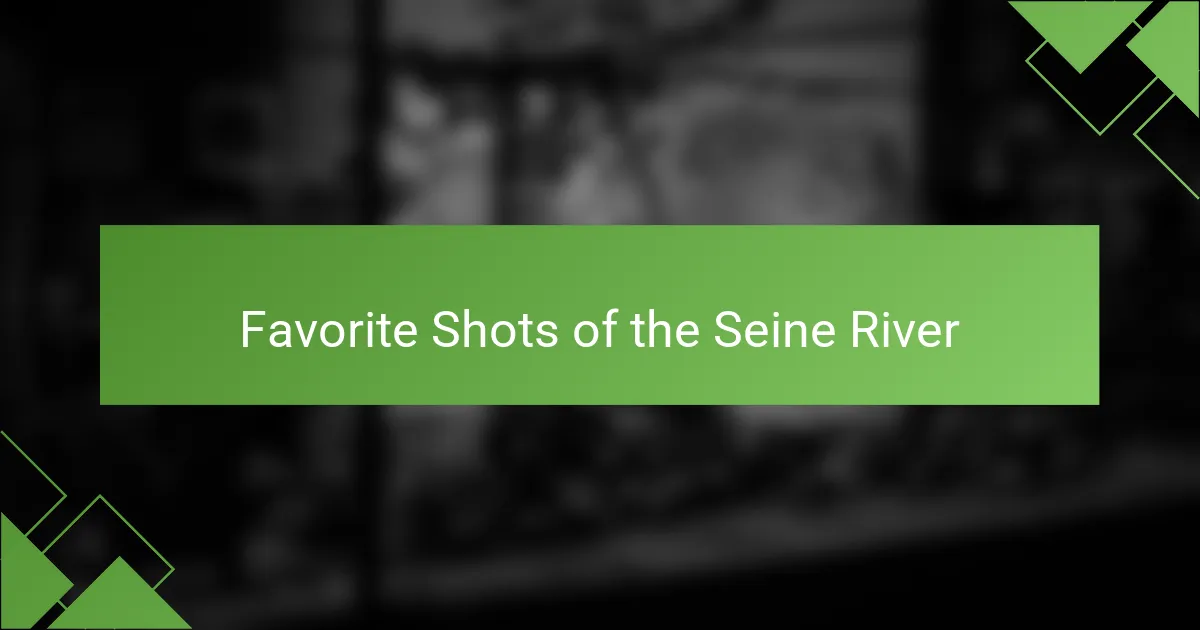
Favorite Shots of the Seine River
When I think back on my photography journey along the Seine River, certain images stand out vividly. One favorite shot captures the soft glow of the sunset reflecting on the water, creating a magical symphony of colors. I remember the tranquility of that moment, where the world seemed to pause, and I could simply breathe in the beauty around me.
Another memorable frame features the iconic Notre-Dame Cathedral framed by the branches of the blooming cherry trees. The juxtaposition of the ancient stone structure against the delicate pink blossoms always struck me as a reminder of the harmony between history and nature. It’s a scene that evokes a deep nostalgia in me, reminding me of countless strolls along the riverbank.
Finally, I often revisit a shot of the vibrant street artists nestled on the banks, adding life and energy to the serene river backdrop. It was a moment filled with laughter and creativity, one that captures the heart of Paris. That sense of community and expression is what makes the Seine more than just a river; it’s a canvas of stories.
| Shot Description | Emotional Insight |
|---|---|
| Sunset Glow | Tranquility and reflection on life |
| Notre-Dame & Cherry Blossoms | Nostalgic harmony of history and nature |
| Artists on the Banks | Vibrant community and creativity |